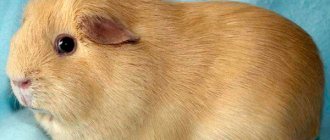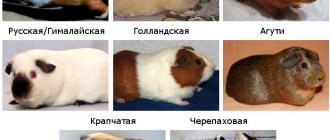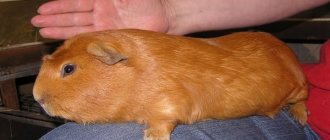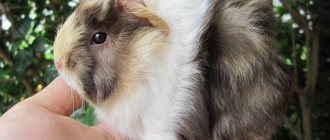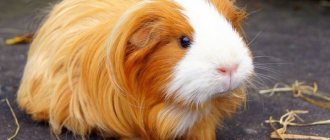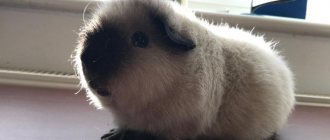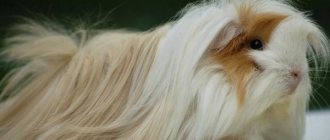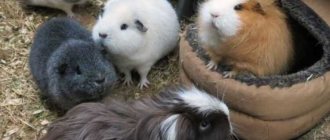Keeping smooth-haired guinea pigs at home
Smooth-haired guinea pigs do not require special conditions for comfort. They need all the same accessories for life as most pigs. Of course, like any small pet, a pig needs a cage.
The cell arrangement is standard. The pig needs a place to rest, a “dining room”, a “restroom” and a play area.
Cell
For smooth-haired pets, choose a cage with a plastic tray. The minimum dimensions for one pet are 80*90 cm, height 35 cm.
The cage contains:
- A reserve for hay, where the animal can feed itself with dry grass and also build a nest for itself;
- feeder;
- sippy cup;
- tray;
- house;
- toys;
- litter
The cage must be installed on a straight surface without tilting
It is important to avoid direct sunlight and drafts when choosing a location for the cage. Before putting hay in the cage, you need to knead it well with your hands.
Experienced breeders use soft dried timothy grass.
Caring for the animal and cleaning the cage
To keep your animal clean, you will need to carry out the following procedures:
- Combing out fur;
- trimming claws;
- water procedures;
- ear treatment;
- home cleaning.
The fur should be brushed daily. This procedure will remove dead hair and stimulate the growth of new fur. This activity will bring your pet a lot of pleasure, because the brush massages the skin. It is better to choose a brush with natural soft bristles.
A rodent needs a manicure just like its owner. Uncut legs grow, curl and become the cause of musculoskeletal problems, as well as bacterial diseases. To keep the animal clean and healthy, it is necessary to trim its claws once every 2-4 weeks with a special nail clipper or electric file. These tools are sold at pet stores. When trimming, you need to be extremely careful so as not to touch the nerve and vessel located at the base of the claw. To perform the procedure correctly and safely, it is recommended to consult a veterinarian or study the relevant materials on caring for pigs.
Water procedures are not so necessary. The pig cleans its own fur. But there are times when a pet is so dirty that a bath is indispensable. For swimming you will need:
- bath with anti-slip mat;
- water with a temperature of 24 degrees;
- special shampoo;
- terry towel.
It is important to ensure that water does not get into your pet's ears. Immediately after bathing, the pig should be wrapped in a towel, as these animals are susceptible to colds.
Minor stains and daily wet care can be carried out using special wet wipes.
Cleaning the ears is a very important step in caring for your pet. You need to clean your ears regularly with a stick soaked in chlorhexidine. If there are dried crusts in the ears, then the Bars solution is instilled into the ears. It is sold in pet pharmacies. And if your pet squeals when trying to clean its ears, then you need to take it to the veterinarian. Perhaps an ear mite has settled in your pet's ear canals.
Cleaning the cage consists of daily washing the feeder and disposing of leftover food. The litter needs to be changed twice a week. General cleaning, which includes treating all surfaces of the cage and objects, is carried out once a month.
Feeding and water
Guinea pigs are fed 2 times a day. In the morning they offer fresh vegetables, fruits and herbs, and in the afternoon dry food (cereals, seeds, bran).
Your pet's diet must include:
- Grains and seeds;
- fresh vegetables (carrots, cucumbers, beets, boiled potatoes);
- fruits (apple, pear, berries);
- fresh grass and hay (lettuce, dandelion);
- bran.
Your pet must have clean and fresh water in his cage. It is recommended to add a solution of vitamin C to it.
To grind down your pet's teeth, you need a mineral stone.
Pigs should not be fed:
- Dairy and fermented milk products;
- meat, fish, eggs;
- cooked dishes (fried, spicy, smoked);
- spicy vegetables (radish, pepper, onion);
- cabbage
Smooth-haired guinea pigs are distinguished by their unpretentiousness, ease of care and maintenance, as well as their friendliness. This makes them a favorite among breeders. And the bizarre types of pets’ fur cannot but delight their owners.
Hygiene
You can bathe your alpaca guinea pig with mild shampoos for rodents or products from a line of professional cosmetics for animals. After bathing, the pig must be dried, absorbing moisture with a towel and finishing the process with a hairdryer with warm air.
Nail trimming is a mandatory procedure that is carried out from an early age, 1-2 times a month. For trimming, use a small, sharp nail clipper that fits comfortably in your hand. The pig needs to be placed on your lap with its belly forward and, carefully taking its paw, trim the free edge of the claw at such an angle that it does not interfere with the stable position of the paw.
Regular hygiene procedures do not include prevention against external and internal parasites. Any medical intervention must be carried out according to the indications of a veterinarian who specializes in rodents.
In order not to encounter resistance from the guinea pig during grooming, it must be accustomed to procedures from early childhood. If your pig experiences pain while trimming its nails or brushing, it will be difficult to gain its trust in the future.
Keeping long-haired guinea pigs at home
Let's look at the requirements for the conditions of keeping and caring for long-haired guinea pigs, and also tell you what you should not feed your pet.
The choice of cell should be approached responsibly:
- cage dimensions - 60x40x60 cm;
- materials - metal and plastic;
- necessary accessories - a drinking bowl, a manger for hay, a feeder for bulk feed, a mineral stone, twigs of an apple or birch tree, a small house, a tray with sawdust.
The cage must be equipped with the following accessories:
- The drinking bowl is purchased at a pet store; its volume does not matter, since the products are standardized and therefore suitable for almost any guinea pig.
- The manger should be made of plastic to make it easier to clean. Choose a ceramic feeder for factory mixtures so that your pet turns it over less often. Wooden products are not suitable, as they not only absorb moisture and odors, but are also damaged by rodents.
- Mineral stone is used to grind down teeth that grow throughout life. If the guinea pig does not have such a stone in its cage, then it will begin to sharpen its incisors on the first objects it comes across.
- Twigs are needed so that the rodent does not have the desire to sharpen your furniture or wooden accessories. The presence of stone does not eliminate the need for branches.
- The house is used by the pet as a shelter, as well as an escape from too bright light. For this reason, it is better to buy a cage together with a house, or purchase it separately from the very beginning.
- A tray of sawdust is used by rodents as a toilet. This allows you to change the bedding in the cage every few days, and also eliminate the appearance of an unpleasant odor in the room.
- Small sawdust or large shavings are used as the main bedding. Since wood absorbs moisture and odors, after removing the chips there is no need to further rinse or disinfect the tray.
Cozy corner
Care and hygiene
The main emphasis in care is on the coat to avoid tangling. Three to four times a week, the pig is combed with a soft brush, after lightly sprinkling water on the hair to reduce tugging. Combing begins only after the tangles have been removed. It is recommended to trim pigs with very long and thick fur before summer.
It is also recommended to trim the hair around the nipples of lactating females. A guinea pig should be bathed if it is very dirty. Having completed the washing, it is dried with a terry towel and dried with a hairdryer, making sure that the hot air does not burn the animal.
Care and maintenance
It is important to immediately note that this pig was created to look luxurious. Its purpose is to participate in exhibitions and amaze with its beauty
This animal is not suitable as a first pet or gift for a child. Caring for a Sheltie pig takes a lot of time.
Therefore, even being an experienced pig breeder, it is important to assess your readiness to spend a lot of time on the animal every day. If there is no such readiness, you should prefer a pig of another breed
The cage where the pig lives should be large and spacious, with a wide range of toys. You need to clean your pet's cage daily.
The Sheltie needs to be thoroughly combed every day, at least three times a day. One session should last several minutes. It is better to comb your pig with a special comb from a pet store, made of wood, with small, frequently spaced teeth.
During the combing process, it is important to remove specks and debris from the fur - sawdust, straw, etc.
In order not to damage the hairs or scratch your pet, you need to run the comb through the animal’s hair carefully and carefully.
To facilitate the movement of the animal and simplify care, too long hair is shortened with small sharp scissors, but only if there is a long time before the exhibition or the animal does not participate in them at all. A trimmed Sheltie with hair shorter than 25 cm will not be allowed to perform. To make life easier for an overgrown pet, its strands are wrapped in curlers. But this does not replace repeated daily combing.
You need to bathe the animal regularly, 2-3 times every month in warm, but not hot water. For washing, use special high-quality products purchased at a pet store - shampoo and conditioner (or balm) against tangling. Water procedures are best carried out in a large basin. The bottom should be non-slip, for this you can line it with fabric. When bathing the animal, water should not get into its ears. After washing, it is better to dry the fur with a hairdryer. After drying, the wool is lightly sprinkled with talcum powder.
Description
Guinea pigs come from the family of semi-ungulate rodents. They have the appropriate appearance and body structure.
- The body shape of rodents resembles a small cylinder. It can reach 22 centimeters in length. Sometimes there are representatives of larger sizes.
- The spine of pigs has a complex structure and consists of cervical, lumbar, sacral, thoracic and caudal vertebrae.
- The collarbone of these animals is completely absent, and the same applies to the tail.
- Boys are much larger than the female half of animals. An adult guinea pig weighs on average 1.2 kilograms.
- The limbs of guinea pigs are small. The hind legs are longer than the front ones.
- Animals have three toes on their hind legs, and four on their front legs. They look like small hooves.
- In a week, an animal's fur can grow half a centimeter.
- The shape of the head is very large. Has a high degree of brain activity.
- Animals' teeth grow continuously throughout their lives. In a week, incisors can grow by 1.5 millimeters. These mammals have very powerful teeth, so the animals can easily gnaw roots and plant stems.
- The digestion process takes a fairly long period of time. This is explained by the large length of the organ.
- Guinea pigs can be found with either long or short fur. The color of the cover is not limited to one color and can be varied.
- In the wild, the maximum age of animals does not exceed seven years. At home, it is determined by the proper care and maintenance of the pet. The lifespan of a domesticated rodent can reach fifteen years.
Self
The Selfie is an Old English breed developed in the 19th century. A uniform uniform coat color, a neat nose with a slight hump, a large head, a dense oval body are the characteristic features by which these pets can be recognized. When you bring a new “resident” into your home, take care in advance of a spacious, comfortable enclosure, provide high-quality meals three times a day, based on 50% vegetables, 30% fruits and 20% cereals. Selfies are incredibly playful and active animals, especially at a young age. Provide them with free access from the cage, giving them the opportunity to run around the apartment 1-2 hours a day, satisfying their natural abilities.
Self
Longhair
Shaggy breeds have thick, long fur and are in great demand among lovers of fluffy decorative rodents. They were bred artificially and subjected to strict selective selection.
Breeds whose standard officially includes a pure white color include the Peruvian (Angora) and Abyssinian guinea pig, Merino, Sheltie, Coronet, Texel and alpaca.
Abyssinian
This is the most interesting and most recognizable breed. The Abyssinian guinea pig has one very striking distinctive feature that immediately sets it apart from other varieties.
The Abyssinian coat must have so-called rosettes. They are a kind of funnels and appeared as a result of a genetic mutation.
Each Abyssinian guinea pig has about 6-10 rosettes on its body. They are located throughout the body and are absent only on the head and belly of the animal. Occasionally, the Abyssinian guinea pig has so-called “double rosettes.”
Their maximum number can reach 30 pieces. The animal's long fur can be painted in almost any color, including white.
Alpaca
Alpaca guinea pigs are covered with long, curly hair, the structure of which is more reminiscent of sheep's fleece. It grows from the tail to the head and forms a pair of rosettes on the rump and one on the crown. Representatives of the alpaca breed have coarser hair on their faces.
The color of the animals can be almost any color, including white. Occasionally among alpaca guinea pigs there are two- or three-colored individuals.
Coronet
The Coronet guinea pig has very long hair that flows down the sides and does not cover the face. There is a single rosette on the animal's head.
The coronet guinea pig comes in a variety of colors. It can be either monochromatic or combined. It is noteworthy that the white coronet is not very popular among breeders. It is believed that outwardly it loses to its brighter brothers.
Texel
The Texel cavy is covered with curly hair, the length of which reaches 15 cm. It grows from the head to the back of the body and cascades down the back.
The Texel guinea pig can have almost any color. Among the representatives of the breed there are even white individuals.
Merino
The breed was created by crossing a Coronet and a Texel. It has a crown-shaped rosette on its head and long, wavy fur that is white, gray or other colors.
Sheltie
The Sheltie guinea pig has long hair that does not flow along the sides, but simply falls back. More dense hair grows on the animal’s head, creating a kind of mane.
The Sheltie can have almost any color. But the white representative of this breed attracts less attention than his colored counterparts.
Peruvian
The Peruvian pig is also called the Angora pig. She has an aristocratic appearance and beautiful fur. There are rosettes on the nose and sacrum. The animal's muzzle is covered with long bangs. The Peruvian pig, or angora, weighs up to 1.5 kg and lives up to 6 years. It is painted in almost any color, including white.
Most often, Peruvian guinea pigs have silver-gray fur. Solid white color is extremely rare in the breed. Therefore, such caves are highly valued by breeders.
The long, soft coat of Angora Cavies grows straight forward. She needs careful care. Peruvian guinea pigs need to be brushed and trimmed regularly. And white animals can occasionally be washed with special shampoos for rodents.
Grooming
Alpacas need careful care for their fur. The creation of a long, beautiful curl is influenced by the genetic factor, the quality of nutrition and care of the animal.
The first need for caring for an alpaca is regular brushing. A straight metal comb and a massage brush made of natural bristles are suitable for these purposes. You need to comb most carefully, carefully sorting out tangles on dry wool.
To preserve the length and structure of the coat, you can twist the wool into curling irons. To do this, you need to separate a strand of wool and, after applying a thin layer of oil to it with a comb, carefully wrap it in curl paper and secure with an elastic band.
If the pig is not intended for a show career, the length of the coat can be shortened with sharp hairdressing scissors with rounded ends.
Distribution of guinea pigs in Europe
During the years of the conquest of South America, the conquistadors gradually moved deeper into the continent and, naturally, encountered rodents weighing 1.0-1.5 kg in Indian villages and also ate them. Before setting off on the return voyage to Europe, pens were made on ships, and the herbivorous guinea pigs became a constant supply of fresh meat. True, some of the uneaten specimens ended up like unusual exotic pets in the homes of wealthy Europeans. Cute little animals quickly became fashionable among noble ladies and they began to be imported specifically for sale, and later bred in suitable conditions in the countryside. So they quickly spread throughout European countries, and then came to Russia.
Guinea pigs have become favorite decorative animals for children and adults around the world, and breeders have continued selection in other more aesthetic directions. If, as a result of painstaking work, a more curly or miniature guinea pig appeared, the price for it increased sharply, which is why today many selective ornamental breeds are sold all over the planet and the selection work continues.
Nowadays, guinea pig breeds are divided into groups, which include:
- short-haired, with a subspecies of smooth-haired;
- long-haired;
- wire-haired;
- without wool and with a small amount of wool.
A more detailed description of the guinea pig breeds in each group is further divided and each of them has its own leaders in popularity among amateurs and professional sellers.
Representatives of the short-haired group are the easiest to adopt at the initial stage of becoming interested in guinea pigs.
Below are just the most popular guinea pig breeds among pet lovers.
History of the breed
This breed is a real “royal person” among its relatives, and its stunning appearance and always fashionable “hairstyle” have made it very popular among rodent lovers. The history of the appearance of this breed is also very interesting. The Sheltie is the result of artificial selection and the breed dates back to 1938 by crossing Peruvian and American varieties. But the breed finally took shape and received universal recognition only in 1978. After numerous experiments, guinea pigs with magnificent silky strands on the back of various colors were obtained. This breed is certainly one of the most popular at shows.
Description of the Alpaca guinea pig
Everyone knows a Peruvian pig with a very aristocratic appearance, reminiscent of a wig when you look at it from above?! So the alpaca is in no way inferior to her! It's just a curly wig! And some exhibition visitors mistake this pig for a Maltese dog. But of course, everyone will want to touch her, and then squeeze her. And the pig will not object, and maybe even talk to you by quietly nodding.
Crested
Large rodents with short, smooth hair, on the frontal part of which there is a neat miniature crest - this is the Crested breed. Their color can be varied: from fiery red to coal black. They are unpretentious in care and nutrition, lead an active lifestyle mainly at night, and are incredibly sociable and trusting. In the summer, be sure to walk your pet on fresh lawn grass (use a special harness). Crested pigs may have certain problems with their teeth, so a mandatory condition for keeping them is the presence of a mineral stone in the cage.
Crested
Rare breeds
In addition to the ordinary guinea pigs that are familiar to most people, there are breeds with a non-standard appearance that look very exotic and original.
Kui
These are real giants in the kingdom of guinea pigs. Adult pigs can reach a length of up to 50 centimeters, and the largest pigs weigh from 1.5 to 4 kilograms.
In their homeland, Peru, these animals serve as a source of meat, where they are raised on special farms. And although some hobbyists keep furry giants as pets, cooi are not the best pets, as they are quite aggressive and often bite their owners. In addition, the lifespan of kui is much shorter than their smaller cousins, and on average they live no more than 3 years.
Swiss Teddy
These rodents are considered the fluffiest among their short-haired counterparts. The main feature of Swiss Teddies is their “crimped” wool. Fluffy and curly animals look like a soft fur ball, and some owners compare their pets to dandelions.
Ridgeback
Very interesting representatives of short-haired pigs, which have a woolen comb along their spine, giving the rodents a somewhat aggressive and angry appearance.
At the moment, Ridgebacks remain a small and rare group of guinea pigs that have not received official registration as a separate breed.
Himalayan
Animals of the Himalayan breed have a specific and original appearance. In fact, they are albinos, who have pigmentation in certain areas of the body, in this case black or dark gray.
The animals' fur is completely white, and the ears, tips of the paws and the area around the nose are painted in a dark shade.
Like Ridgebacks, Himalayans are not yet recognized as a separate breed, and breeding work to consolidate their standards is still underway.
Tortoiseshell with white (cakes)
A rare and very valuable guinea pig among breeders, on whose body black, red and white spots alternate in a certain way.
Unlike ordinary tri-colored “turtles,” the tortoiseshell-and-white breed has an interesting checkerboard-like pattern on its back, formed by even colored squares. Because of this three-layer effect, the animals are affectionately called “cakes.”
Lunkaria
A relatively new breed that has not yet become widespread. Lunkaria have a long luxurious coat, and each strand is curled into a tight, slightly harsh curl. And, if in other curly pigs the hair straightens out when combed and becomes simply fluffy, in lunkarias after such a procedure the strands curl up again into a tight curl.
Curley
These beautiful animals are similar to curly lunkarias, as they also have tight, coarse curls. The only difference between them is that the Curlie has shorter hair. Thoroughbred individuals have dense curly fur, the fur on the belly is also curled, and there are always whiskers on the cheeks.
Mini-yak
One of the recently bred and rarest breeds. These delightful animals combine the features of three breeds: the long hair of the Peruvians, the rosettes characteristic of the Abyssinian pigs and the hard, slightly curly fur of the Rex.
The mini-yak has long strands of hair sticking out in different directions due to the vortices that are formed, and the bangs fall over the eyes or to the side, so the rodent looks a bit like a disheveled parrot.
Somalia
A new and very rare breed that is just waiting for official recognition. Somalis look like Abyssinians, as they have rosettes on their bodies, but the structure of their coat resembles the curly fur of the Royal Rex.
All types of guinea pigs are so different, but they have one thing in common: they are extremely trusting, affectionate and gentle pets
And it doesn’t matter at all what length or structure the fur of a cute rodent is, because in any case, the little animal needs love, care and attention
Diet
The alpaca guinea pig is a pure vegetarian and it will not be difficult to create a diet for it.
What foods can be included in the diet:
Dried grass
Hay should be collected in ecologically clean areas, away from industrial enterprises, highways and cities. In addition, the grass must be properly prepared and well dried. Hay is the main component of a pig's proper diet and should be available at all times.
You can make hay yourself or find it at a pet store. The second option involves careful product selection. The hay should be clean, fragrant, soft to the touch and fragrant.
Fresh herbs
Greens can be grown independently or collected in ecologically clean areas: nettle, burdock, early sedge, plantain, wheatgrass, rapeseed, spurge and other non-poisonous plants. In addition to herbs, you can diversify your diet with parsley, dill, and tops.
Juicy feed
These include fruits and vegetables. The safest option is products grown in your own garden plot and purchased from trusted places. The most popular of them are carrots, apples, cucumbers, pumpkins and other products that are not included in the list of prohibited foods.
Ready-made feed
Pet stores offer a wide range of food for guinea pigs. Alpacas do not need large quantities of food and can do without it at all. When choosing food, you need to focus on the minimum content of grains, dyes and other components unacceptable for alpacas.
Vitamins and treats
The most correct diet, rich in natural products, contains all the necessary vitamins and minerals for alpacas. Additional vitamin supplements should only be taken as recommended by a veterinarian.
Most treats on the market contain excessive amounts of sugar, grains, dyes and flavors. They can harm the alpaca's health and shorten its life.
Water
Clean fresh water must be available at all times. Filtered or boiled water is suitable for these purposes.
Prohibited foods for alpaca guinea pig diet:
- Onion garlic;
- Citrus;
- Potato;
- White cabbage;
- Tomatoes;
- Nuts and seeds;
- Fats, sweets, bread and other table foods;
- Animal protein in any form;
- Poisonous plants;
The alpaca guinea pig is a cute little animal that looks like a soft toy. Often a pig is bought as a playmate for children, which is unacceptable. Alpaca is a fragile and timid animal that will not play with humans.
In addition to joy, these animals cause a lot of trouble: they chew things, make noise at night and leave feces on the floor. An alpaca lives for 5-8 years and before deciding to live together for such a long time, you need to carefully consider all the nuances.
Baldwin
Baldwin pigs do not have hair. Their skin has a uniform light beige tint, and in some places it is covered with tiny folds. When purchasing such an animal, keep in mind that its skin is more susceptible to injury and inflammation. Periodically inspect your pet for any abrasions or scratches. If you are going to walk your Baldwin on the street, then choose a place for walking with special care: avoid polluted and dusty areas. These rodents are quite smart, cunning and friendly. When potential danger threatens, they deftly hide in a house or shelter.
Baldwin
Guinea pigs are amazing creatures that are popular among pet lovers. Most of them have a soft, calm, flexible character. Aggression occurs extremely rarely or is completely absent. The average life expectancy is 8-10 years. Provide your pet with quality care, and then he will delight you for many years.
Reviews
According to reviews from alpaca owners, these animals are an excellent choice for a pet. They are very friendly and quickly make contact with people. In addition, they are quite smart. However, you should also take into account the fact that pigs can make noise at night . As mentioned above, they need careful care, so before getting an animal, soberly assess your strength, because if the rules are not followed, the animal can become very ill or even die.
For information on how to properly care for a guinea pig, see below.
Rex
Rex is an officially recognized species of guinea pig, protected by the world organization UNESCO. Distinctive features: unusual short fur of a rigid structure, ears turned inward, long paws with sharp claws, pretty eyes resembling black beads. Rexes are friendly, active and calm, but in some situations they can be stubborn (for example, refusing certain food). Despite the length of the hair, it is recommended to comb it periodically with a special brush. Also follow the correct diet: fresh plant foods (vegetables, grass, greens) should predominate in the diet of these pets. Ready-made food makes up 30% of the main menu.
Rex
Ridgeback
Ridgebacks were bred in Sweden in 2004. Their most important external feature is a woolen comb running along the entire length of the back. The color of the hair is varied: from creamy white to ash black. Caring for your pet is incredibly simple: periodically comb out split hairs, introduce vitamin-mineral complexes into the diet during the spring molting period, and visit a veterinarian annually for a routine examination. Ridgebacks are very loyal and sensitive creatures. They do not like to be left alone for a long time, they adore the company of people, and are friendly towards other pets.
Ridgeback
general characteristics
Before purchasing an alpaca as a pet, it is important to familiarize yourself with all the characteristics of the animal. The alpaca guinea pig got its name from its long wool, which in its softness and smoothness resembles the wool of cloven-hoofed alpacas.
By their biological nature, these rodents are not natural. Alpaca is a hybrid specially bred by American scientists
The alpaca guinea pig got its name from its long wool, which in its softness and smoothness resembles the wool of cloven-hoofed alpacas. By their biological nature, these rodents are not natural. Alpaca is a hybrid specially bred by American scientists.
In terms of its dimensions, a guinea pig can reach a length of no more than 20 centimeters, and can weigh about 1 kilogram. However, these indicators mostly concern males, and females of the species are usually smaller and lighter.
By itself, it is quite fluffy and thick, reaching a length of 12 centimeters. Moreover, the entire body is covered with wool, including the head (here the alpaca has real bangs).
As for the color of the animal, it can be very diverse (usually multi-colored rather than monochromatic). So, quite often there are combinations of white and black, red, etc.
The lifespan of alpacas varies between 5–8 years. Most often it is at the lower end of this range, but if the animal is healthy and properly cared for, it is possible to extend life by several additional years.
Reproduction
The ability to reproduce in alpacas appears from the second month of life. However, in order to obtain viable and healthy offspring, rodents should not be crossed so early. A more optimal option would be to cross at least 4 months.
During pregnancy, females can be very aggressive and bite, so at this time they can rush at a person, and therefore you should be very careful (especially children).
The gestation period for furry pets lasts about 2 months, and at one time they can give birth to 2 or 3 babies (this number is typical in the first pregnancy, in subsequent times the number of babies can increase to 8).
Other interesting varieties
The Curly pig's fur is gathered into tousled curls. They look long, but they are not. You won't be able to comb them perfectly. And it's not necessary. The animal looks funny and is pleasant to the touch. The pig is reminiscent of Teddy and Rex in terms of the stiffness and unruliness of its fur. The body length of the Curly reaches 25 cm. The weight of an adult is 1 kg.
The Lunkaria pig is genetically closely related to the Curly breed. Only her fur is longer and more tousled. Another unique breed among guinea pigs is the Kui breed. An adult specimen weighs up to 4 kg. These rodents are bred for fur, meat and fertilizer production.
There are many guinea pigs in nature. Geneticists continue to develop new breeds for exhibitions. In the Russian Federation, some nurseries are engaged in breeding rare species. In ordinary pet stores, only popular short-haired varieties are found. They are easier to keep at home.
Alpaca guinea pigs: history of origin
To date, there is no single generally accepted opinion regarding the origin of this breed of guinea pigs. Some experts believe that they mutated from crossing two breeds - the English Peruvian and the Rex. This is very similar to the truth, because the alpaca pig actually has features of both the Peruvian pig and the rex in its appearance. It is also impossible not to note the similarities (especially with regard to wool) with the Texel, Merino and Coronet breeds.
Choosing and arranging a home
For a Peruvian guinea pig, you need to purchase a spacious cage, terrarium or enclosure.
All equipment must be durable and reliable so that food does not spill or water spills. In a spacious cage, you can equip a separate toilet, because pigs like to go to one place. This simplifies the cleaning that needs to be done daily.
It is best to place the cage in well-lit areas.
Keeping animals in a dark corner of the room has an adverse effect on the health and behavior of the rodent, so breeders are urged to place the cage near a window. However, in this case, drafts, which are destructive for Peruvians, should be carefully avoided.
It is very important that the place to sleep is comfortable. It is not recommended to buy houses, because pigs can hide there and become unsociable
It is better to choose a hammock or tunnel made of soft material.
Alpaca cage
Generally speaking, alpacas should be kept in a cage. However, this cage must be large and spacious. The optimal cell size is considered to be 50 centimeters by 70 centimeters. Thanks to this area, the animal will be able to move freely around its home and feel some space.
It is not recommended to keep several animals in one cage, as aggressive fights may arise between them over the division of territory.
The bottom of the cage must be covered with dry grass, which should be changed regularly.
During the warm period of the year - spring and summer - you can use fresh grass, however, it must first be disinfected (this can be done with boiling water) so that the animal does not contract diseases or become infected with pests.
In addition, the cell itself should not be empty. It needs to be filled with a variety of additional elements and items for entertainment, toys. For example, you can put a running wheel or a house.
Choose a cage made of durable material (it is best to give preference to metal or wood). Thus, the animal will not be able to break its home, and it will last for quite a long period.
Subtleties of care
Guinea pigs are quite unpretentious; the main difficulty in caring for a rodent lies in processing the fur to avoid its severe tangling. The pig needs to be brushed 3-4 times a week.
To avoid having to pull the hairs, it is better to lightly spray them with water from a spray bottle. Keep in mind that you can start combing only after the tangles have been completely removed. If the animal’s fur is too long and too thick, then by summer you can trim the pet a little. Also, the hair of lactating females is cut, but not completely, but only the areas near the nipples.
From time to time, the guinea pig needs to be bathed with a special shampoo for animals, after which it is blotted with a warm terry towel and dried with a hair dryer (keep it at a distance so that too hot air does not burn the small animal).
Some breeders curl the hair of their rodents with curlers, thus the animal gets the opportunity to move quickly, and the hairs do not roll off or get dirty
The ears of a hairy rodent are carefully cleaned with cotton wool, the eyes are treated as necessary and sharp claws are trimmed.
Every breeder must understand that the health of pets primarily depends on the correct diet. Its imbalance leads to rickets, scurvy, obesity, allergies and cardiovascular diseases.
Pathologies of non-infectious origin can also include:
- a cold that quickly turns into bronchitis and pneumonia;
- keratitis and acute conjunctivitis;
- otitis;
- epilepsy;
- baldness;
- cystitis;
- malignant tumors.
The most common viral infections are:
- plague;
- paralysis;
- pseudotuberculosis;
- amoebiasis;
- toxoplasmosis;
- trichomoniasis;
- salmonellosis;
- enteritis;
- herpes;
- ringworm.
Also keep in mind that due to the peculiarities of physiology, any injury or fall can lead to the death of a furry pet.
The rules for caring for a long-haired guinea pig are discussed in the following video.
Their pride is wool
It is impossible not to notice that it is wool that distinguishes alpacas from other representatives of the species. All alpaca guinea pigs are incredibly fluffy creatures. Their fur is simply unrealistically long. Regular rosettes of wool decorate the entire body of the rodent. A distinctive feature of the breed is the presence of regular rosettes on the sides of the animal. Also, one rosette can grow on the muzzle itself. This rosette looks like a bang, only sometimes it hangs so much over the animal’s eyes that from time to time it needs to be trimmed a little.
Also, the difference between this particular species is the presence of attractive sideburns. The fur on the animal's face is always a little coarser than on the rest of the body. This wool feels like sheep's wool. The coat color can take on almost any color and shade. Let's highlight several alpaca colors:
- golden;
- black;
- redheads;
- white.
On some individuals you can see a combination of several colors. Most often in nature, two-colored alpacas are found. The presence of three different colors is very rare.
Health and diet
Representatives of this breed are in good health. Animals' bodies are not susceptible to viruses and infections, so they rarely get sick. Problems can only arise with the animal's fur, but they can easily be solved with proper and regular hair care, as well as proper nutrition.
The diet consists of vegetables, herbs, and fruits. Cereals and grains should make up no more than 25%. Just like other pigs, animals should not be given meat, dairy products, canned food and sweets.
It is advisable not to place the cage with your pet in drafts or in the sun. Like other pig breeds, alpacas are sensitive to temperature changes. A comfortable heat level for alpacas is 22–24 degrees. In summer, it is advisable to take them outside or onto the balcony, but you need to take into account that in the heat and direct sunlight the pet may become unwell.
If the animal is not allowed to run around in a safe space, then it may be susceptible to obesity. Obesity is bad for your pet's health, so for its well-being it is better to secure some space so that the animal can run around to its heart's content.
